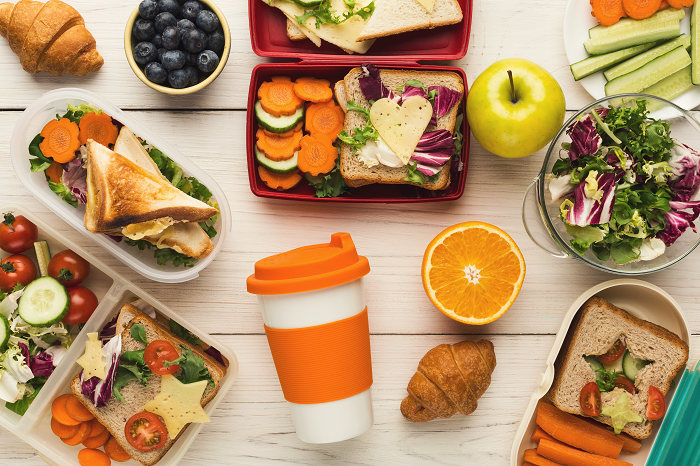
We all get stuck in a rut when it comes to school lunches, but they are well worth our attention. Good nutrition helps our children to concentrate, to perform at their best and also regulates mood. Children go through major physical and mental growth, which means that their nutrient needs are obviously significant. It doesn’t need to be complicated; sometimes simple is best (see ‘back to basics’ below).
Poor nutrition can lead, not only to weight problems (over or underweight), but also to some illnesses linked with malnourishment (contrary to popular belief, this is not always limited to lower-income classes).
A particularly fussy child with a limited palate can have a lower immune system and can be susceptible to recurring infections, particularly in winter. When it comes to improving the quality of their lunchboxes, try not to be overwhelmed or overly negative. All it takes is a bit of inspiration to get back on track again. The aim is to provide unprocessed foods in an appealing way, and for it not to take too much preparation or time.
Good Habits for Life
But there’s even more to it than that; giving them healthy lunches also helps to set a healthy mindset for them around food. Providing your children with the good stuff helps educate them about healthy eating and the importance of taking care of their bodies and their brains as they progress through life.
Using the car analogy usually works well (ie. you wouldn’t put poor quality petrol into a sports car and expect it to run well, so the same goes for your body). Ideally their day starts off with a healthy, nutritious breakfast (and try to make time for them to sit and eat it at the table), and that should continue for the rest of the day, with healthy lunches and dinners.
We aren’t saying that it all has to be perfect; just good enough. And sometimes we could all do with raising the bar a little. That could simply mean being more mindful of including more vegetables in their diet – even if that means ‘hiding’ them for the fussy eaters. With a clever bit of planning, you’ll get all the nutrients on the ‘menu’.
Go Back to Basics For Nutrients
In terms of nutrients, it’s good to remind ourselves what we’re trying to pack into their lunchbox. The crucial ones include; protein, carbs, fats, calcium, iron, fibre, vitamin C and vitamin D.
1) Protein: helps to builds muscle and other tissues. It helps them boost their immune systems and also assists with feelings of satiation (especially important if your children are constantly hungry!).
Good sources: fish, chicken, turkey, lean meats, nuts, eggs, milk, yogurt, cheese, peanut butter, and edamame beans.
2) Carbs: children are different to us, in that they are much more active (and are growing rapidly) which is why – if their weight is not an issue – it’s fine that carbs make up a significant proportion of their total food intake. The important factor here is that the carbs should be from good sources (ie. ones that don’t leave them hungry – read more here). Complex carbs should make up the bulk of a child’s diet because these don’t cause a rapid rise in blood sugar. They are also more nutrient dense, supplying key nutrients such as fibre and B vitamins.
Good sources: wholegrain bread and crackers, popcorn, quinoa, or brown or wild rice. Limit refined grains such as white bread, pasta and rice (these simple carbs cause a rapid rise in blood sugar and usually contain few beneficial nutrients).
3) Healthy Fats: healthy fats are key for brain and nerve growth. They help with healthy metabolism, blood clotting, and the absorption of some important vitamins. They also help stimulate a hormone that tells the body it’s full and satiated, called leptin, so healthy fats can actually play an important role in weight control.
Good sources: tuna, mackerel, salmon, trout, sardines, flaxseeds, chia seeds (I sprinkle them on their porridge), walnuts and green leafy vegetables such as kale and Brussels sprouts.
4) Calcium: is vital for the development and maintenance of healthy bones and teeth.
Good sources: Dairy products like milk, and fortified soy milk, yoghurt, cheese, tofu, sardines and dry cereals. It is also present in lesser amounts in vegetables such as broccoli.
5) Iron: helps to make red blood cells, which carry oxygen in the body, and also helps with children’s growth (especially important during periods of accelerated growth).
Good sources: beef, turkey, fish, beans, lentils, green leafy vegetables and fortified breads and cereals.
6) Vitamin C: essential for healing and fighting off infection; it also strengthens tissue, muscles, and skin.
Good sources: oranges, kiwis, strawberries, tomatoes, potatoes, Brussels sprouts, red peppers, spinach, and broccoli.
7) Vitamin D: this vitamin helps the body form and maintain strong teeth and bones and assists with the absorption of minerals such as calcium. It also plays an important role in maintaining a healthy immune system (read more here).
Good sources: fortified dairy products, cereals and oily fish (such as salmon and sardines), as well as cod liver oil. Small amounts are also found in beef, liver, cheese and egg yolks. Adequate exposure to sunlight is one of the best ways to get enough vitamin D, although that can be a challenge in Ireland, which is why many parents are now recommended to include fortified products in their shopping trolleys (such as supermilks).
Some (Hopefully New) Ideas
Take your pick:
- Hummus or sundried tomato pesto dip with wholemeal pitta bread ‘triangles’ and/or celery sticks or carrot batons
- Grapes with ‘cubes’ of cheese
- Cucumber or red pepper slices
- Sliced Oranges
- Dry cereal
- Ham or cheese quesadilla (still tasty served cold)
- Guacamole or salsa with homemade tortilla ‘chips’ (just dry-fry and cut into triangles)
- Strawberries and pineapple ‘kebabs’ (ie. fruit on a cocktail stick)
- Apple rings (spritz with fresh lemon to prevent browning)
- Hard Boiled Eggs
- Low sugar muffins/cookies
- Pretzels
- Savoury chickpea pancakes
- Quinoa or bulgur wheat with raisins and toasted pine nuts (unless your school is nut-free, in which case, use dried cranberries)
- Wholemeal pasta salad (with crunchy broccoli florets – simply boil and then blanch in cold water)
- Greek yogurt (lower in sugar and higher in protein that regular yoghurts)
- Homemade granola bar or Motivation protein bar
- Raspberry ‘coulis’ (my daughter mashes raspberries with a fork for a delicious raspberry coulis that can be sealed and eaten on its own or added to yoghurt – it’s a much healthier alternative than yoghurts with an added fruit layer)
- Almond or peanut butter wraps (if nuts are allowed)
- Wholegrain crackers with cheese
- Homemade frozen yoghurt (it might melt a little but if well sealed, it should keep okay until little break.)
- Bagel with smoked salmon and cream cheese
- Fresh pineapple chunks (served with a small fork)
- Baby tomatoes
- Edamame or sugar-snap peas (they’ll have fun popping them out)
- Vegetable spring rolls (still delicious served cold)
- Falafel (handy sized and vegetarian so ideal for lunch boxes)
- Homemade soup (served in a thermos flask, for older children)
- Sushi (when the budget allows)
- Olives (not to every child’s taste, but some do love them!)
- Vegetable frittata (https://motivation.ie/recipes/vegetable-frittata/
For More Information
Visit Safefood.ie
If you want to get your children more involved and more educated about healthy eating, visit this great website for printables to download and hang up at home.
Click here to check out our free Healthy Back To School Recipes booklet.
It’s packed with great advice and a selection of super recipes.



